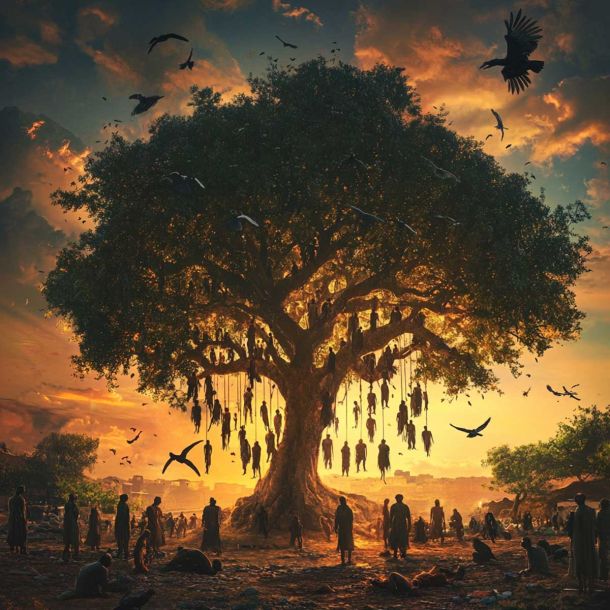MORE COVERAGE
Twitter Coverage
Satyaagrah
Written on
Satyaagrah
Written on
Satyaagrah
Written on
Satyaagrah
Written on
Satyaagrah
Written on
JOIN SATYAAGRAH SOCIAL MEDIA
"The Enemy Within, The Greatest Challenge for Hindus of Bharat": A tale of unity tested by time & choice, from Jagat Seths' pivotal decisions to Kerala rulers' alliances with the Portuguese, history reveals the profound consequences of short-sightedness

For the Hindus of Bharat, the message is clear and as ancient as time: in unity, there's strength. Taking inspiration from the profound fable of the bundled sticks, where the lesson is "united we stand, divided we fall," Hindus have often seen the merit in staying unified. Yet, much like the sticks in the tale, achieving unity hasn’t been an easy journey. In the absence of a strong overarching leadership, divisions have periodically emerged within the community.
|
Historically, the grand tapestry of the subcontinent has seen numerous power plays, as various ruling factions jostled for dominance. Such rivalries often carved out spaces that were then easily exploited by those with ulterior motives.
Bharat, with its rich tapestry of cultures and traditions, has always been an inviting land for explorers, traders, and sometimes invaders. Many of the early foreign visitors like the Kushans, Sakas, and the Yavanas didn't take long to get enchanted by the local customs and traditions. Over time, they gradually assimilated, adopting the ways of the land as their own. Their contributions became parts of the cultural mosaic, adding new dimensions without attempting to overshadow the existing ethos.
However, the same warmth and inclusivity wasn't reciprocated by all. Some invaders, particularly those subscribing to Abrahamic creeds, held a different perspective. Rather than blending in, they sought to superimpose their beliefs, causing deep cultural upheavals. The ripples of these invasions have persisted, with Bharat's illustrious civilization still grappling to recover from the consequent cultural decay. These events didn't just leave physical scars but also sought to change the very essence of Bharat's identity.
Throughout history, internal division and the absence of a collective vision have often been the Hindu community's Achilles heel. Some factions, swayed more by personal ambition than a shared purpose, became pawns in larger geopolitical games. Take, for instance, the story of the “Jagat Seths.” This influential banking family from Punjab, settled in Bengal, reportedly amassed wealth that rivaled, if not surpassed, the British crown's coffers. Their monumental role in the Battle of Plassey, where they financed the East India Company, can't be understated. This financial backing was instrumental in the Company's victory over Siraj-ud Daulah, paving the path for the British to tighten their grip over the fertile and prosperous Bengal region.
Notably, this paradigm-shifting victory came a mere six years after the Marathas’ unsuccessful bid to free Bengal from the chains of foreign rulers. One can't help but ponder the course Indian history might have taken had the Seths chosen to back the Marathas during this critical juncture. Such "what if" moments underscore the profound impact of internal choices on the larger narrative of a civilization.
|
Navigating Modern Strains: The Unheeded Lessons of the Past
Today's society echoes with stories of the Sindhi Hindu community's distressing predicament, bearing witness to painful decisions and their aftermath. The Sindhi Hindus, deeply rooted in the soil of their forefathers, faced a gut-wrenching displacement. While their roots ran deep, their leadership at the time appeared to lack foresight. Prominent leaders like Purushotamdas Thakurdas and Jethmal Parsram Gulrajani passionately championed for Sindh's separation from the broader Bombay province, believing they were preserving the unique Sindhi identity. This decision, however, ignored a pivotal aspect: the ensuing Muslim majority of the region.
It's not as if these leaders were venturing into uncharted territories without any warning. The Hindu Mahasabha, with its deep-seated understanding of the socio-political landscape, persistently tried to enlighten them about the potential repercussions of such a move. Their entreaties, rooted in pragmatism, went unheeded. Tragically, the very lands the Sindhi leaders so earnestly desired to separate became alien to them in the turbulence of 1947, just ten years post the detachment from the Hindu-dominated Bombay Presidency.
Parallel stories of demographic upheavals were unfolding in the nation's eastern front, particularly in Assam. While it's easy to point fingers at the British colonizers for initiating the large-scale relocation of Bengali Muslims (mainly from Mymensingh) into the bountiful Brahmaputra valley, the local elites and thinkers too played their part. Motivated by the allure of increased revenue, they inadvertently approved the settlers' takeover of untouched tribal regions. The noted Assamese playwright, Jyoti Prasad Agarwala (of Marwari lineage), coined the term “Na-Axomiya” (translating to 'neo-Assamese') for these Bengali Muslim migrants taking up residence along the Brahmaputra's banks. In merely a few decades, regions such as Nagaon and Goalpara began reflecting the cultural landscape of East Bengal more than that of Assam. Agarwala's assumption — that merely adopting the local language would ensure seamless integration — seems naïve in hindsight. Today, the indigenous inhabitants of these areas either seek refuge elsewhere or endure grim circumstances.
Shifting our gaze to the South, specifically to the region now known as Kerala, we observe similar tales of internal conflict exacerbating vulnerabilities. The longstanding disputes between the Samoothiris of Kozhikode (or Calicut) and the monarchs of Kochi (previously Cochin) inadvertently laid a welcome mat for external, particularly Abrahamic, influences. In a move marked by shortsightedness, Kochi's ruler, Unni Goda Varma, entered into an alliance with the Portuguese. The repercussions were far-reaching. The once-dominant Hindu culture saw its fabric strained as European and native Christian missionaries engaged in aggressive proselytization. The demographics shifted alarmingly; Hindus, who once constituted a significant majority, witnessed their numbers dwindling to 71.52% in 1881 and further to 63.41% by 1941. A parallel trend emerged in the neighbouring British district of Malabar, with Hindu numbers slipping from 72.4% in 1872 to a mere 63.08% by 1941.
In summary, these episodes from different corners of India emphasize the importance of unity, foresight, and the need to prioritize collective welfare over personal gains. They serve as reminders that internal disputes, when coupled with a lack of vision, can have consequences that echo for generations. The narratives underline the significance of safeguarding cultural heritage and learning from past missteps to ensure a more cohesive and harmonious future.
|
Enduring Challenges: Kerala and the Weight of Choices Past
Venturing even further southwards, we encounter the story of the kingdom of Travancore, a realm of richness both culturally and in terms of its resources. While this region also displayed an openness to European influences, it resulted in missionaries experiencing unchecked authority. Rani Gowri Parvathi Bayi's choice to introduce education for her subjects in 1817 was indeed a noble endeavor. However, the consequences of assigning the administration of this education to Christian missionaries proved dire for the indigenous religious community. The realm that reveres Shree Padmanabhaswamy underwent a drastic shift in its demographics. Hindus, who were predominant at 83.0% in 1820, witnessed their representation shrink to a mere 60.5% by 1941. During the same period, Christians surged from 12.4% to a significant 32.3%. By the dawn of independence, the northern regions of Travancore, spanning areas of Idukki, Ernakulam, and Kottayam, already portrayed an almost equal representation of Christians and Hindus.
Delving deeper, it's evident that the benevolence and accepting nature of the Kerala monarchs inadvertently paved the way for missionary endeavors. Prominent missionaries like Thomas of Cana, who received benefactions from Cheraman Perumal as early as 345 AD, and Sapir Iso Maruwan, bestowed rights by Venad king Aiyan Atikal Thiruvadikal in 825 AD, seized these opportunities. With fervent devotion, they spread their faith among the unsuspecting local populace. The queen of Kollam's actions in 1516 is another glaring instance. Eager to fortify her alliance with the Portuguese and secure a prominent stake in the thriving spice trade, she not only sponsored the reconstruction of razed churches but also sanctioned conversions to Christianity.
Throughout history, there's an evident pattern: the Hindu community's internal rifts, susceptibility to divisive forces, and the struggles for unity. This cyclical dynamic of unity followed by divisions is a recurring theme in the annals of our past. The repercussions of treachery and short-sightedness from various quarters have left lasting impacts, the tremors of which are palpable even today. While minority groups are often swift to voice concerns on a spectrum of issues, a significant portion of the Hindu community seems to miss the broader civilizational context.
It's startling how ephemeral offers of benefits can sway loyalties, resulting in governments teetering on the brink of losing their mandate. Given these volatile dynamics, it becomes clear why governments tread a tightrope, prioritizing retaining their hold over implementing essential reforms. The tug-of-war between immediate appeasement and longer-term vision has always been a daunting challenge.
In conclusion, understanding history's episodes and their subsequent impacts is pivotal. Not just as a chronicle of the past, but as a compass guiding the choices of the present, ensuring the pitfalls of yesteryears don't dictate the path of tomorrow.
 Support Us
Support Us
Satyagraha was born from the heart of our land, with an undying aim to unveil the true essence of Bharat. It seeks to illuminate the hidden tales of our valiant freedom fighters and the rich chronicles that haven't yet sung their complete melody in the mainstream.
While platforms like NDTV and 'The Wire' effortlessly garner funds under the banner of safeguarding democracy, we at Satyagraha walk a different path. Our strength and resonance come from you. In this journey to weave a stronger Bharat, every little contribution amplifies our voice. Let's come together, contribute as you can, and champion the true spirit of our nation.
 |  |  |
| ICICI Bank of Satyaagrah | Razorpay Bank of Satyaagrah | PayPal Bank of Satyaagrah - For International Payments |
If all above doesn't work, then try the LINK below:
Please share the article on other platforms
DISCLAIMER: The author is solely responsible for the views expressed in this article. The author carries the responsibility for citing and/or licensing of images utilized within the text. The website also frequently uses non-commercial images for representational purposes only in line with the article. We are not responsible for the authenticity of such images. If some images have a copyright issue, we request the person/entity to contact us at satyaagrahindia@gmail.com and we will take the necessary actions to resolve the issue.
Related Articles
- Snappy wisecrack of Rahul Gandhi on ‘Hindu vs Hindutva’ and his frequent trips to temples and other confusing steps
- Global elite has always loathed a confident India: Earlier NYT & BBC had declared Nehru intolerant
- Sanãtana Dharma Versus Prophetic Creeds - Defence of Hindu Society
- Tales of Fraud, funding, forced religious conversion and insulting Hindu gods and goddesses after brainwashing: How tribals were converted to Islam in Gujrat - “Aapka paigam London pahucha diya hai, achha kaam ho raha hai"
- Islam Imposes an Emergency on India - Freedom of Expression
- The untold exodus of 1.5 lakh Punjabi Hindus to Delhi’s Piragarhi camp; forced upon by Sikh radical Khalistani terrorists led by Bhindranwale
- Secularism ideology of India views and appeases Indian Muslims As Pakistanis
- The Situation at Present - Defence of Hindu Society
- Propaganda to Vilifying Hindutva by media: Gurugram protesters seeking Kalicharan Maharaj’s release dubbed as ‘Anti-Namaz brigade’
- 'Worshipping Sun is a complete No-No, it has been birthed by Allah': MLC Gulam Rasool Balyawi from JDU opposes Surya Namaskar on January 12
- The untold story of Maharashtrian Brahmin genocide committed by Congress after Gandhi’s assassination in 1948
- Erotic slurs, explicit images, and rape threats, how hostility towards Hindu women continues unflagging on social media
- Owaisi bole toh 'Peace', Narsinghanand bole toh 'hate speech': Owaisi played the victim and filed a complaint, leading to an FIR against ‘Dharma Sansad’
- Speech of Sardar Patel at Calcutta Maidan in 1948 busts the myth of ‘Muslims chose India’ and is relevant even today
- 'Hinduon se Azadi', 'La ilaha illallah' and 'Ghazwa-e-Hind' slogans by Muslims was secular leading to Genocide of Kashmiri Pandit: Then and now, from Azadi slogans to Hindu hate, the nature of Jihad and its apologists remain unchanged



























